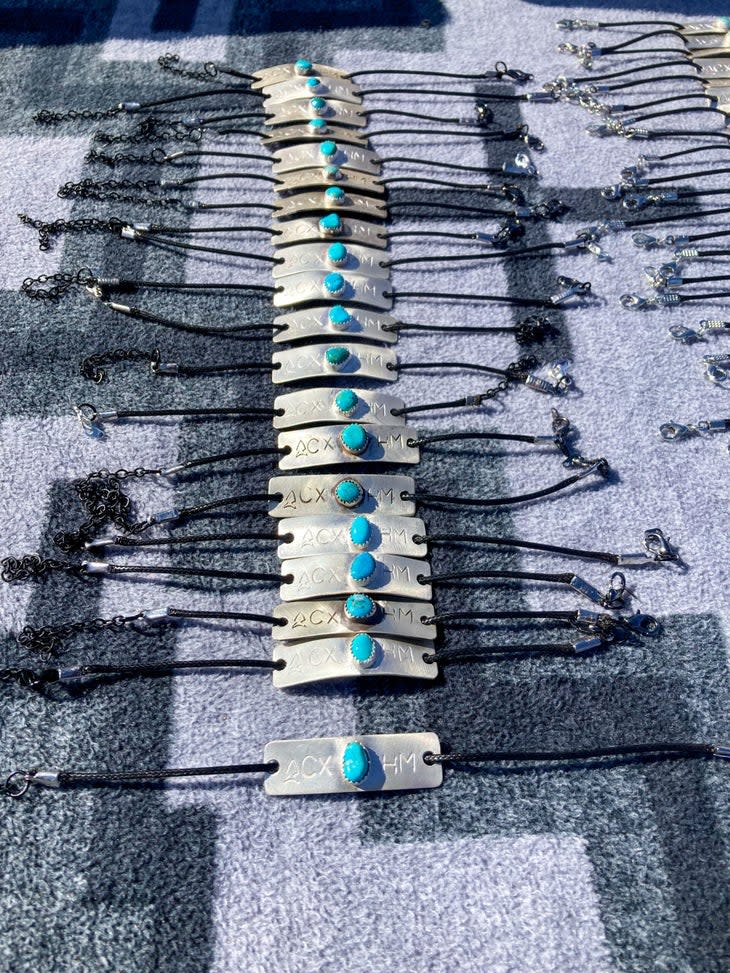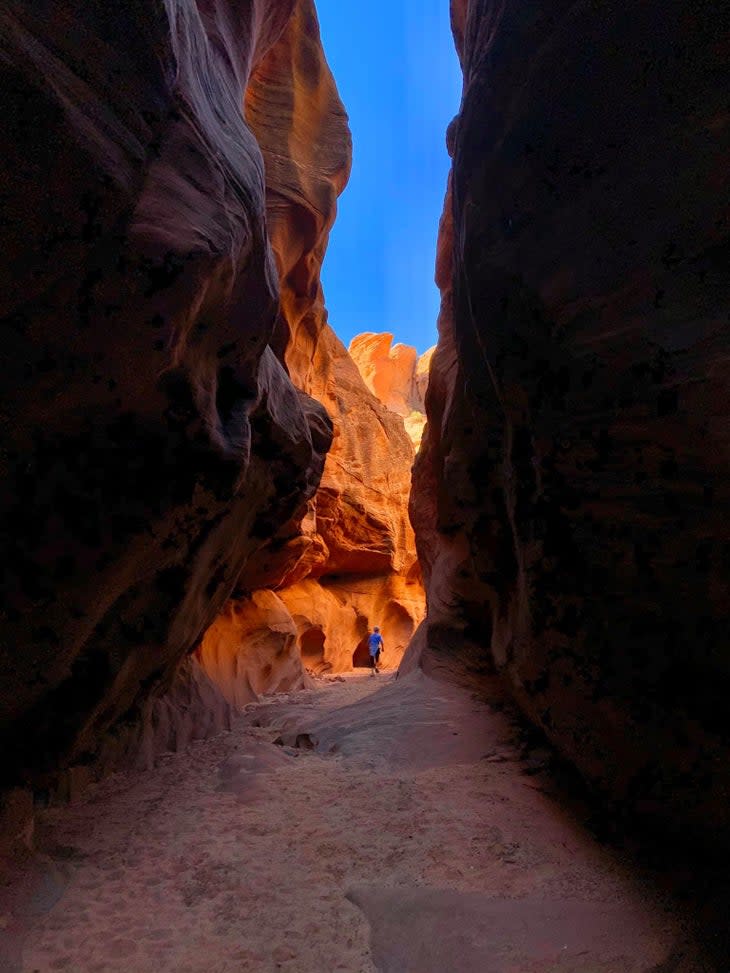The Antelope Canyon X Half Marathon is About More Than The Numbers
This article originally appeared on Trail Runner
The Antelope Canyon X Half Marathon is not like other races. It takes place near Page, Arizona, in the slot canyons on Navajo land. The course includes sections of deep sand, double-track, and narrow slots that require bouldering and ropes and ladders. And while some people go for time in an all-out effort, many take in the scene at a slower pace, appreciating the incredible red rock walls and the way the light shines through the canyons.
It's a race, but it's also a reunion. A remembrance. A celebration. The morning of the event, race director Harold Bennally sprinkles corn pollen on the start/finish line. He says a Navajo prayer and gives a brief history of the place. He hands the microphone off to others, constantly thanking people, constantly including people. Then he counts down to the start, right at sunrise.

How it Began
Bennally initially organized the race in 2018 to raise money to make his dream of racing the Boston Marathon in traditional Navajo moccasins come true. He approached mother-and-son business partners Rita Tadytin-Tsingine and Logan Tsinigine, who coordinate Taadidiin Tours through Canyon X, about putting on a race.
"Honestly, we didn't know what we were getting into," Logan said. "We did a lot of planning with Harold, and the race was a huge success. Since things went so well, we agreed to make it an annual event."
Now the goal is to create an experience for others--family and friends, but also people from l around the world. "The race this year went really well," Bennally said. "It gets better and better every year."
This April, the race had 200 runners, which is about the limit for the canyons and the volunteers. Some slots’ sections get narrow and would feel congested with too many runners. Plus, the experience of near solitude with the rocks is special compared to races with thousands of people, say, pouring onto the trails of Chamonix.
"We have lots of runners from Arizona," Bennally said. Those who grew up in the area want a reason to return. But people also travel for the opportunity to experience the slot canyons in such a unique way. "We had runners from California, Colorado, Utah, New Mexico," Bennally said. "We also had runners from Canada, New Zealand, and even Sweden."
Bennally ran the Boston Marathon in 2019 in traditional moccasins and has since used money from the race to help fund off-season training trips for Navajo high-school runners--to the Grand Canyon, Phoenix, and Flagstaff. He's become an inspiration to other runners in the area. Running is deeply rooted in the Navajo tradition--Ha'a'aahjigo dighadideeshwol when many run east each morning to greet the day.
Bennally grew up running in the canyons, which is where he got the idea for the race. He wanted other people to experience the energy of the rock and the sand and the sky above.

History of the Canyons
No one is allowed into the slot canyons without a Navajo guide. Logan and Rita have been guiding people for many reasons, mainly to preserve history and create a new reality of positive experiences that are very different from what their ancestors endured.
"The elders felt that part of our history was sad and tragic, so they were reluctant to tell people outside of our family," Logan said. "But so many people have asked, so we teach them."
"Before the Europeans arrived, the Navajo people moved around with their livestock. They moved to where the grazing was best, the location of water catches, where they grew crops, best locations for winter and other geographical advantages. The Tadytin family gets their last name from an ancestor named Tadidinii. The government referred to Tadidinii as Taddy Tin, because they couldn't spell Tadidinii.
"The Navajo base word in Tadidinii is Tadidin, which translates to 'corn pollen.' The "ii" is added to the end to make the name Tadidinii, specific to a person, and not corn pollen. Corn pollen is sacred and used in our prayers."
Nearly 54 years before his death, Tadidinii and other Dine warriors avoided the Long Walk of 1864. The U.S. Army, led by James Carleton and Kit Carson, forced more than 10,000 Dine people at gunpoint to walk hundreds of miles to Fort Sumner in New Mexico. Many, many Navajo people died. But Tadidinii hid in the slot canyons and protected others who escaped.
He was murdered in the winter of 1916 by federal agents. Tadidinii’s Daughter had run away from the Tuba City Boarding School because of abuse. Federal agents were sent to bring Tadidinii in by any force necessary to oppose this daughter’s return to boarding school. He was shot three times. Logan is the great-great-grandson of Tadidinii.
"Tadidinii had a corn field and home near a place called Bii Hooteel [Wide Valley]. Bii Hooteel is located on the south rim of Antelope Canyon. Tadidinii's son, Clyde Tadytin made a permanent homestead in Antelope Canyon, and that's when the tradition of moving around with livestock ended. Clyde Tadytin liked to share stories and show people the land. He guided many of the first people that came to Antelope Canyon."
RELATED: The Man Who Created a 200-mile Race to Reconnect With His Ancestors

Sharing the Story
Today, Logan and his family like to show people the canyons as a safe haven for the Navajo who were avoiding capture. "Runners can look at the canyon as a safe haven, too," Logan said.
So Bennally and Logan often sprinkle corn pollen in Tadidinii's honor. The Dine people think of Tadidinii as a protector--a reminder that the Dine were never conquered because of the ones who avoided the Long Walk, and because of the canyons.
"The more you share, the more you build community," Bennally said. He wants people to experience the canyons in a meaningful way. "A lot of times the culture of the canyons gets ignored. People want the photos and then they go home. But those canyons mean more to us than just a photo. So with the race we can present our culture, and really share an experience."
For months leading up to the race, Bennally hand-makes finisher bracelets and winner necklaces out of silver and turquoise, in the traditional Dine style to honor his culture. "The way I've been brought up, I know how good and how precious the culture is. When you get down here on the Rez you see a lot of jewelry stands. People do that for their living, their livelihood. Beading, making jewelry, doing things with their hands to put food on the table.
"My grandmothers were beaders, my grandfathers were silversmiths. I wanted to make something so that people can take home a piece of the Navajo nation and wear it, not just let it collect dust."
RELATED: Indigenous Runner and Artist Yatika Fields Creates Beauty at the Western States 100

A Transformational Experience
Sergio Avila is an Indigenous runner from central Mexico who works as a wildlife biologist. He moved to Arizona 20 years ago for a job at the University of Arizona, because of his unique skill set studying many animals and animal habitats. He ran the Canyon X race in April and says it's easily his favorite race experience.
"Harold is my favorite race director because he really highlights how running is more than just the numbers. Running goes back centuries and connects us to the land. It connects local communities. It connects us to so much history."
Avila says it's important for all different kinds of people to show up for running events that are not like what they're used to. "Show up for non-typical running events. Show up for Indigenous running events. And I’m being careful in not calling them races, because a running event also means that it's possible that I’m going to run with my children or my Grandma. And that's an event we're not racing. We're having a ceremony together. Give yourself the opportunity to experience different ways of running."
Avila often relives the canyon run, thinking about the people and the magic of the slots. He plans to return next year to share the experience with even more runners.
Jofauna Shorty grew up in Wide Ruins, Arizona, also part of the Navajo Nation. She ran in April and says it was the first time she had ever run in the canyons. And that she wanted to do it to experience a place that is so significant. "To be there and to actually run through the canyons was surreal. An escape from reality. It's really a unique and rare place. And to run on my homeland and be surrounded by so much beauty was special."
Shorty had been told stories of the canyons but had never taken the time to visit. As a trail runner, when she heard about the opportunity to run there, she knew it was the perfect way to experience the place she had heard so much about. "Everything about Canyon X felt like the highlight of my life," she said.
RELATED: Meet the Indigenous Ultrarunner Attempting The Badwater 135
Always Evolving
Bennally is working to include as many Indigenous businesses in the event as possible. Next year, he hopes to include traditional food at the race’s finish and is looking to partner with an Indigenous-owned T-shirt company. He's also working to start a second running event in a neighboring canyon to Canyon X. "They reached out to me and asked me to do this run. So hopefully, it becomes another race we do every year, too."
Registration for next year isn't open yet, but Bennally hopes to open it soon. He's still deciding on the best date. "I liked the April race--still cool up there and such a beautiful time to be in the canyons."
For exclusive access to all of our fitness, gear, adventure, and travel stories, plus discounts on trips, events, and gear, sign up for Outside+ today.

